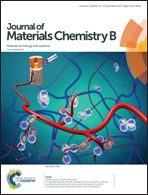A ZnO-gated porphyrinic metal–organic framework-based drug delivery system for targeted bimodal cancer therapy†
Abstract
To overcome the side effects caused by premature drug leakage from carriers and to achieve more efficient cancer treatment via the synergy of photodynamic therapy (PDT) and chemotherapy, a porphyrinic metal–organic framework (porMOF)-based drug delivery system (ZnO-gated porMOF-AS1411) was prepared and its ability to efficiently deliver small molecule drugs was tested. In this system, the porous porMOF plays the dual roles of a PDT photosensitizer and a drug carrier. To overcome premature drug leakage and thus reduce side effects and improve drug delivery efficiency, pH-sensitive ZnO nanoparticles were used to cover the porMOF nanopores. Neutral and alkaline pH-stable ZnO ensured that the loaded drugs were encapsulated in the porMOF pores during delivery. However, ZnO disintegration in the acidic lysosomal environment opened the pores, permitting drug release. Further assembly of nucleolin-specific AS1411 aptamers conferred the nanosystem with target-specific recognition and accumulation abilities. In this work, we demonstrated that the proposed nanosystem could be successfully used to efficiently deliver, with controllable release, the chemotherapeutic drug doxorubicin (DOX), thus achieving bimodal cancer treatment by PDT and chemotherapy. In vitro and in vivo experiments demonstrated that this synergistic therapeutic modality achieved highly efficient cancer cell-killing and tumor ablation without undesirable side effects.



 Please wait while we load your content...
Please wait while we load your content...